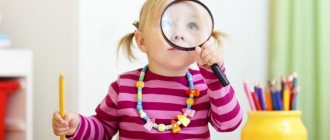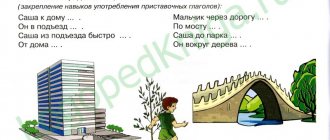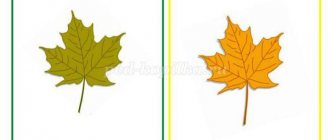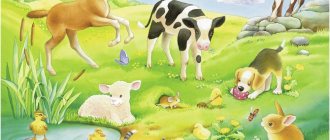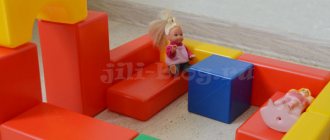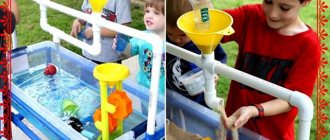Copybooks for preschoolers - letters and numbers
All kinds of copybooks with capital letters and numbers from 1 to 10 are available for preschoolers. The methodological material allows you to develop your hand, fine motor skills, and train concentration and perseverance while performing tasks. To develop logical thinking in preschoolers, it is recommended to use material where numbers are found.
Russian alphabet with tasks
Open
Copybooks with numbers
Open
Recipes for children 5-6 years old
Develop beautiful handwriting in preschool children aged 5 to 6 years. It is advisable to prepare your child for school in advance, since it is at this age that they are easily trained and are able to easily learn something new. If you don't take care of this in advance, children will have a hard time in elementary school.
Capital letters from A to Z
Open
Mathematics copybooks
Open
Recipes for children 6-7 years old
For preschoolers from 6 to 7 years old, it is advisable to use math copybooks, as they will not only be able to develop their hands, but will also easily remember numbers.
Writing aids are also important. With their help, it will be easy to prepare your child for school or help him in first grade. Writing copybooks will not only teach you how to write the elements of letters correctly and at the right angle, but will also help the child learn to read already written capital letters, which often causes a problem at the initial stage of a young student’s education.
Copybooks by points
This type of educational materials has become especially popular today. The dotted recipes are designed for children 5-6 years old.
A child’s thinking at this age is not always capable of assimilating information that he needs to learn to write and count according to certain rules established by the education system. Such standard methods may not be perceived by the baby, so it is better to give preference to learning in the form of a game.
We trace the letters by dots
Open
We trace the figures by points
Open
Circle the numbers by dots
Open
Classes for teaching children 5-6 years old
The “Training” block is aimed at developing and consolidating basic knowledge and skills in the child, which will allow him to more easily adapt to school. The block includes the following topics:
- Mathematics: Section "Counting and numbers"
- Section "Other mathematical representations"
- Section “Preparation for literacy training”
Considering the specifics of the material in this block, the division of tasks within topics into levels of difficulty is very arbitrary. Indeed, it is difficult to say what is more difficult - to learn the number 1 or the number 5, or to master the letter “O” or the letter “W”.
Parents may wonder why a preschooler needs this if all the listed topics are included in the first grade curriculum. This is true. But practice shows that in modern schools children do not have enough time to master all this knowledge “from scratch.” Most modern programs contain a very large amount of information, as a result of which the time for practicing the acquired knowledge is reduced. Therefore, it is better if the child, by the time he enters school, can read and count within ten. This will give him the opportunity to easily adapt to the pace of work in the classroom, make him feel more confident, and reduce the learning load at the stage of adaptation to school. In addition, the game activities offered here in no way duplicate the school curriculum. They are designed for older preschoolers and take into account the developmental characteristics of children of this age. It should also be noted that at the age of 5-6 years, many children themselves show an interest in counting and reading and easily master them with properly organized classes.
Each topic or section includes a certain number of subtopics. Each subtopic has a training part and tasks to test the mastery of the material and consolidate it. The training part is a remote game lesson with an explanation of new things using visual material. Since this is a completely unfamiliar type of activity for a child, we recommend that parents at the initial stage of the child’s work with the block be close to him in order to assess whether the child understands the proposed explanations, whether he is interested, and also to answer questions that arise in a timely manner. If the child does not have time to perceive the material at a given pace (especially when learning letters when reading syllables, words and phrases), use the “pause” button to give the child the opportunity to understand and repeat what is proposed in the explanation. And please show your child how he himself can stop the explanation when he needs to. After the training part, the child is asked to complete several tasks based on the material he has just learned.
Please make sure that your child does not become overtired. One of the advantages of our site is that a child can move through blocks and topics at an individual pace that is comfortable for him, and also return to material already covered.
It is quite possible that your child has already mastered reading and counting. In this case, we suggest that he start working with the block with training tasks. They offer several options to better practice the acquired skills. The difficulty for all options is approximately the same. If the child successfully copes with them, his level of proficiency in counting, reading and basic literacy can be considered more than sufficient.
Dear parents! Please note that during classes the child will need: a piece of not very stiff wire (about 20 cm long), 10 any pencils, plasticine of any color, lace or woolen thread, from which you can cut pieces of the desired size (20-30 cm) .
Patience to you and success to your child! Have fun!
Copybooks for schoolchildren
Such copybooks are often requested at school in order to give the very basics that are so necessary for a child at the initial level of education. Many parents decide to purchase additional worksheets to help them improve their child’s skills at home. In any case, such copybooks provide all the necessary basic knowledge, which will become the foundation for teaching a child to read and write.
Recipes for 1st grade
Copybooks for first-graders can easily be called the main notebooks in elementary school. The child’s task is to learn to write beautifully and quickly. For a child, such a task seems insurmountably difficult. In the first grade educational program, very little time is devoted to copywriting.
The copybooks contain many pictures that make learning easier and help to divert the child’s attention, when necessary, from the difficult task of learning the elements of lowercase letters.
Capital letters and words
Open
Exercise “The fourth is extra” - name the extra one and explain your choice.
Swallow, wolf, hare, cat (an extra swallow, because it is a bird, and the rest are animals) Starling, dog, cuckoo, nightingale. Sparrow, dove, crane, tit. Rook, swan, duck, crow. “Who are there many in the forest?” There are many starlings in the forest (swallow, nightingale, stork, rook, crane, cuckoo, heron, swift) “Count to 5.” One swallow, two swallows, ...... five swallows. (cuckoo, starling, nightingale, stork, rook, crane, heron) “Name the chicks.” rook - rook... duck -... cuckoo -... starling -
Learn a poem about birds with your child. Do finger exercises with him. (when naming a bird, bend your fingers). A flock of birds Sing, sing, sing along, ten birds - a flock. This bird is a nightingale, this bird is a sparrow. This bird is an owl, a sleepy little head. This bird is a waxwing, this bird is a corncrake. This bird is a little gray feather. This one is a finch, this one is a swift, this one is a cheerful siskin. Well, this is an evil eagle. Birds, birds, go home! Clench your fingers into fists
Top
Free online training
Home Preschool
Website: home preschool
Some lessons from the paid full course, which are no longer available for purchase, have been published on the YouTube channel. A parent or other adult can teach the child using available videos.
The quality of recording or editing may not be ideal, but each lesson is filled with the minimum required for the subject, taking into account the characteristics of age. The possibility of using ordinary things as educational material is taken into account.
Masha and company
Website: Masha and company
Preparing for school online with the Masha and Company channel is carried out in many aspects. You can watch fairy tales with your child, make puzzles, play games and study using other educational videos.
For easy memorization and development of children, the author presents all material in a playful way.
Preparing for school is an important stage, which you can cope with together with professional teachers. At the same time, parents should also work with the child so that progress is constant.
Olga Naumova “Logic”
The ability to think logically and reason is necessary for a child to successfully study at school - otherwise he may face difficulties in mastering basic subjects. This manual contains exercises that will help a future first-grader master basic skills - recognize objects by given characteristics, compare and find common and distinctive features, generalize, determine patterns and sequence of events, and solve simple logical problems.
Download the book “Logic” by O. Naumov
Assignment on the lexical topic: “Spring”
Learn a poem with your child. Do finger exercises with him.
Exercise "Spring"
Spring has arrived in the snow,
On a damp carpet. They walk with their fingers on the table.
Scattered snowdrops, Hands on the table, palms down.
I sowed grass. Spread - move fingers.
Now he is calling from all over. Arms are bent at the elbows - fingers are open.
Geese, swifts and storks Bend one finger on each hand.
Cuckoos and starlings.
Top
Assignment on the lexical topic: “Pisces”
Exercise “Little fish and giant fish.” Formation of word formation skills, the use of nouns with the suffixes -ish, -ishka:
gudgeon - gudgeon - gudgeon ruff - brush - ruff,
shark - sharks fish - fish - fish
crucian carp - crucian carp - crucian carp perch - perch - perch
Guess the riddles. Explain how you guessed what words helped you find the answers.
She lives in water.
There is no beak, but it pecks. (Fish)
It crawls the other way around - backwards. (Cancer)
She is the storm of the seas
Get away from her quickly! (Shark)
Development of sound and letter analysis skills.
Draw or stick 10 fish. Write short words in their entirety, and write the first and last letter of long ones.
For example: catfish - COM, flounder - K________A
Learn a poem with your child. Do finger exercises with him.
Fish
The fish swims in the water, the fish arches its back,
The fish have fun playing. I took a bread crumb.
Fish, fish, mischief, The fish waved its tail,
We want to catch you. The fish quickly swam away.
Top
